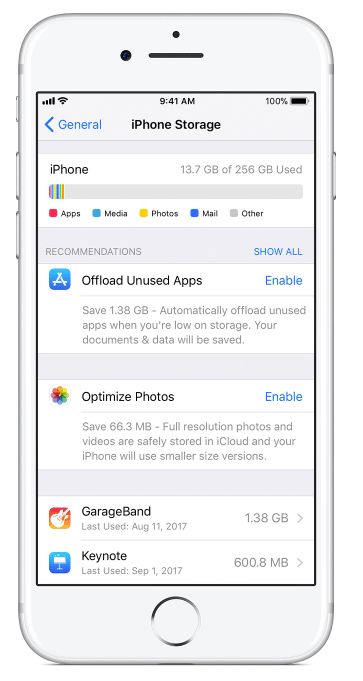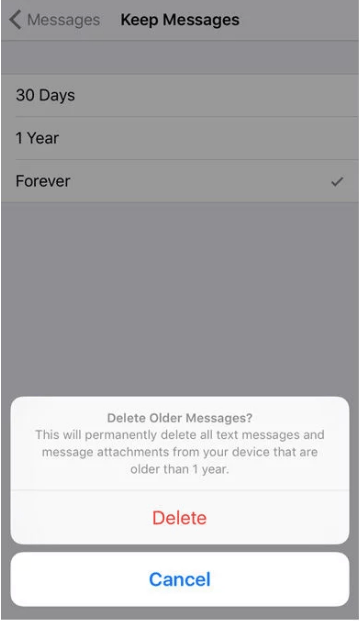The best ways to free up storage on your iPhone

You’re having dinner with your family and one of your kids starts doing something unbelievably cute. So you quickly grab your iPhone to take a video but, unfortunately, that dreaded “Not Enough Storage” message greets you and that fleeting moment is gone forever.
With all the cool stuff our iPhones can do, filling up our storage is always a possibility. If there’s not enough storage, we can’t take pictures or videos, download podcasts or music, add new games or apps, or even install operating system updates that contain important security fixes.
In this tip, we’ll talk about quick ways to free up your iPhone’s storage space so you won’t have to scramble when you need it.
How to check your iPhone’s storage

To see how much space you have left on your iPhone, go to Settings >> General >> iPhone Storage.
Here, not only can you see how much available room you have on your iPhone, it will also give you a list of your apps and how much space they’re taking up. This section provides a quick way to safely offload or delete apps you may no longer need.
Delete or offload unused apps

See an app that you want to delete? In the same iPhone Storage section, you can do this by tapping on the app, then either Offload or Delete it to free up space.
Introduced in iOS 11, “Offload App” means it will delete it but it will keep its documents and data on the phone. If you’re planning on using an app later, this is the recommended option. Note: You can also let your iPhone offload unused apps automatically by enabling “Offload Unused Apps.”
However, there are times when deleting an app completely is the only way to free up significant space.
For example, if you use your Facebook app regularly, its data cache can build up over time, taking up more space than it should. Although apps like Facebook can optimize their space automatically, you can instantly reclaim additional storage space by offloading or deleting them then reinstalling them right back.
Delete text messages

You’ll be surprised by how much space your text messages can actually take up. If you’ve set your iPhone to keep your text messages forever, data from SMS videos and photos will build up over time.
One recommendation is by letting your iPhone delete your text messages automatically by changing your “Keep Messages” setting to a year. If you send and receive a higher volume of texts, you can opt for 90 days instead.
To change this setting, go to Settings >> Messages >> scroll down to Message History then tap “Keep Messages.”
Important: Before you set your message history time limit, keep in mind that you’ll have to manually save the SMS attachments like images and videos you want to keep. Beware that changing this setting will delete all your text messages that are older than the time you set.
Do you want to save your iPhone text messages forever? Tap or click here to read more about your options.
Backup your photos and videos online

For most of us, our smartphones are now our daily digital cameras. Since we carry them around all the time, they’ve become our go-to gadget for our photos and videos.
And we might not need anything else anymore since the quality of our phone cameras keeps getting better. But of course, better quality means larger files and all those great shots can add up and take up precious storage space.
To maximize your space without losing your memories, it is recommended that you upload or backup your photos and videos online.
Apple’s own iCloud Photo Library service maximizes your iPhone’s storage space by backing up full resolution versions of your photos online while keeping lower resolution versions locally on your phone.
To enable this, go to Settings >> Photos then toggle iCloud Photo Library to On.
Keep in mind that your iCloud Photo Library mirrors what you have on your iPhone. This means deleting a photo on your iPhone will delete it from your iCloud library too.
To totally offload your photos and videos and save them online, try a backup photo service like Amazon Prime Photos or Google Photos. These apps can automatically save every photo and video on your Camera Roll to online storage so you can delete them from your phone and still access them anytime.
Even better, for the best backup solution for all your photos and files on multiple gadgets including your computer, we recommend our sponsor IDrive. This means you only need a single account for backing up your family’s computers, laptops, tablets and phones. Get a 50 percent discount on an IDrive subscription, courtesy of Kim Komando!
Manage your music and podcasts

Podcasts are excellent sources of information and they’re one of the internet’s fastest growing trends. For example, Kim Komando’s own Consumer Tech Update podcast is a quick daily dose of the tech news you need to know, mixed with straight talk about “all things digital.”
It’s not hard to fill up your storage space if your iPhone is set to automatically download episodes of podcasts you’ve subscribed to. To manage how your iPhone handles podcasts go to Settings >> Podcasts >> then go to the Episode Downloads section.
To maximize, it’s recommended that you download new episodes only and have your iPhone automatically delete played episodes.
Locally saved music can also take significant space. Since streaming music online is the way to go nowadays, you can delete most of your albums and song tracks on your iPhone and still have infinite ways to listen to music.
If you’re not into music files and you don’t really mind eating through your data cap, you can delete your iPhone’s music files by going to Settings >> Music >> Downloads.
Tags: Amazon, Apple, Apple iPhone, Google, operating system, security
